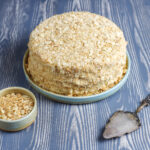Orange cake is a delightful and refreshing dessert that bursts with citrus flavor. If you want to create a moist and flavorful orange cake that will impress your taste buds, here are some helpful tips to guide you:
- Choose Fresh Oranges: Start with fresh and juicy oranges to extract maximum flavor. Look for oranges that are firm, brightly colored, and heavy for their size. Organic or locally grown oranges tend to have a more vibrant flavor. You’ll need both the juice and zest of the oranges for the cake, so make sure to wash and zest them before juicing.
- Incorporate Orange Zest: The zest of an orange is packed with aromatic oils that enhance the flavor of the cake. Use a fine grater or a microplane zester to remove the colorful zest from the oranges. Be careful not to scrape too deeply, as the white pith can be bitter. Add the zest to the cake batter to infuse it with a citrusy fragrance.
- Freshly Squeezed Orange Juice: Use freshly squeezed orange juice for a burst of natural citrus flavor. Squeeze the oranges just before you begin baking to ensure the juice is at its freshest. Strain the juice to remove any pulp or seeds before adding it to the cake batter.
- Balance the Sweetness: Orange cake should strike a balance between the sweetness of the cake and the tartness of the orange flavor. Use a moderate amount of sugar in the batter to let the orange flavor shine through. If you prefer a sweeter cake, you can adjust the sugar amount to your liking.
- Use Buttermilk: Buttermilk is a key ingredient in creating a moist and tender orange cake. It adds acidity and tanginess while keeping the cake light and fluffy. If you don’t have buttermilk on hand, you can make a substitute by combining regular milk with a tablespoon of lemon juice or white vinegar. Let it sit for a few minutes before using.
- Properly Measure Dry Ingredients: Accurate measurement of dry ingredients is crucial for the success of any cake. Use a spoon to scoop flour, baking powder, and other dry ingredients into measuring cups, then level them off with a straight edge. This ensures the right balance and consistency of the cake batter.
- Cream the Butter and Sugar: Creaming the butter and sugar together until light and fluffy is an essential step in cake baking. Beat them together at medium speed until the mixture becomes pale and creamy. This process incorporates air into the batter, resulting in a lighter texture.
- Alternate Dry and Wet Ingredients: When adding the dry ingredients and buttermilk to the batter, do so in alternating batches. Start and finish with the dry ingredients, mixing just until combined after each addition. This technique helps prevent overmixing and ensures an even distribution of ingredients.
- Bake at the Right Temperature: Follow the recommended baking temperature in the recipe. Most orange cakes bake well at around 350°F (175°C). Monitor the baking time and check for doneness by inserting a toothpick or cake tester into the center—it should come out clean or with a few moist crumbs attached.
- Orange Glaze: Enhance the orange flavor by brushing the baked cake with a simple orange glaze. Mix freshly squeezed orange juice with powdered sugar until smooth and drizzle it over the warm cake. This adds a lovely citrusy sweetness and helps keep the cake moist.
- Cool and Frost: Allow the cake to cool completely before frosting. You can choose to keep it simple with a dusting of powdered sugar or frost it with a tangy cream cheese frosting or a light orange-flavored buttercream. Decorate the cake with orange zest or slices for an extra touch of elegance.
12. Serve and Enjoy: Slice the cake into portions and savor the bright and tangy flavors of the orange cake. It pairs well with a cup of tea or coffee and is perfect for special occasions or as a refreshing treat any day.
By following these tips, you’ll be able to create a delicious orange cake that is moist, flavorful, and a true citrus delight. Enjoy the process of baking, indulging in the aroma of oranges, and savoring the tangy-sweet goodness of your homemade orange cake.








